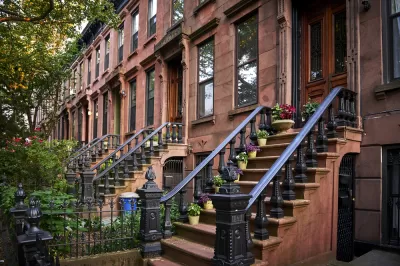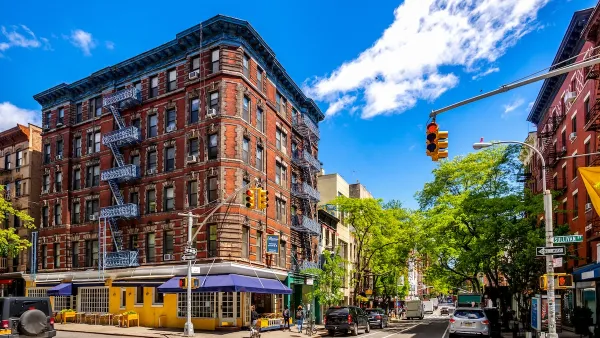Community resistance may explain why smaller apartment buildings are hard to build.

Every so often, I read something like this: "The only reason people wanted to downzone their neighborhood was because they didn't want 100-story skyscrapers" or "most people can tolerate density as long as you reason with them and don't build too much." The basic theory underlying these kind of statements is: anti-development activists aren't opposed to development, they are just opposed to humongous development, and if we just build duplexes and small apartment buildings (or, as new urbanists like to say, the "missing middle" between detached houses and large apartment buildings) they will not be controversial.
But this theory does not always correspond with reality. For example, yesterday I had a conversation with a local lawyer who was outraged that someone had turned a house in her neighborhood into a duplex. The homeowner had not built a 100-story skyscraper, or even a 10-story apartment building. They had just added one housing unit—but to my acquaintance, one was too many. Why? In this intown neighborhood, homeowners park on the street. And to my acquaintance, one new resident meant one new parking space, which in turn means that someone might lose their God-given right to park in front of the house.
Thus, homeowners' desire to park their cars on public streets means that even one new unit of housing may be met with community outrage. In other words, even the tiniest bit of housing development will be controversial.* (Although this story involves just one incident, I have read plenty of other stories about neighbors opposing small apartment buildings and rowhouses.)
Neighborhood concerns about parking may be one reason why the "missing middle" has become more rare in recent decades. Someone who builds a 20-story high-rise might, if government demands it, find a way to add parking, and to pass the costs on to tenants or condo-buyers. But someone who adds a unit to their house (or even a small apartment building) might not be able to add parking so easily. Thus, in urban areas parking may actually be more of an obstacle to “missing middle” housing than to high-rises.
Moreover, a large developer has more ability to negotiate than someone building a four-plex or an accessory unit. If I want to build a 35-story high-rise, and my neighbors object to it, I might be able to shave a few stories off the building and still make a profit. By contrast, if I am turning my house into a duplex, I don't have much room to negotiate: either I build an extra unit or nothing at all.
So paradoxically, the current zoning system of "rule by neighbors" may be designed to prevent a city of skyscrapers—but by making approval of small buildings difficult, the system actually may shift investment capital into larger buildings.
Is this a problem? If you worry about affordable housing, probably yes, since even small buildings add to the housing supply. If you favor a "human-scale city" combining walkable neighborhoods and small buildings, probably yes, because the status quo prevents new small buildings from being built.
On the other hand, if you believe housing for current residents' cars is more important than additional housing for people, or if you just like your cities dominated by tall buildings and detached single-family homes, the status quo is perfectly fine.
So what's the alternative? If you want to bring back the "missing middle" the logical solution is to treat duplexes and small apartment buildings like single-family homes—that is, to make them an as-of-right use wherever a single-family house is an as-of-right use.**
*According to my acquaintance, the unit was approved by the city only because the homeowner had misled the government into thinking that the unit would be used for a music studio. So because of parking, housing is now more controversial than music.
**For a more detailed discussion of how to use form-based codes to allow "missing middle" housing, go here.

Planetizen Federal Action Tracker
A weekly monitor of how Trump’s orders and actions are impacting planners and planning in America.

Map: Where Senate Republicans Want to Sell Your Public Lands
For public land advocates, the Senate Republicans’ proposal to sell millions of acres of public land in the West is “the biggest fight of their careers.”

Restaurant Patios Were a Pandemic Win — Why Were They so Hard to Keep?
Social distancing requirements and changes in travel patterns prompted cities to pilot new uses for street and sidewalk space. Then it got complicated.

Platform Pilsner: Vancouver Transit Agency Releases... a Beer?
TransLink will receive a portion of every sale of the four-pack.

Toronto Weighs Cheaper Transit, Parking Hikes for Major Events
Special event rates would take effect during large festivals, sports games and concerts to ‘discourage driving, manage congestion and free up space for transit.”

Berlin to Consider Car-Free Zone Larger Than Manhattan
The area bound by the 22-mile Ringbahn would still allow 12 uses of a private automobile per year per person, and several other exemptions.
Urban Design for Planners 1: Software Tools
This six-course series explores essential urban design concepts using open source software and equips planners with the tools they need to participate fully in the urban design process.
Planning for Universal Design
Learn the tools for implementing Universal Design in planning regulations.
Heyer Gruel & Associates PA
JM Goldson LLC
Custer County Colorado
City of Camden Redevelopment Agency
City of Astoria
Transportation Research & Education Center (TREC) at Portland State University
Camden Redevelopment Agency
City of Claremont
Municipality of Princeton (NJ)






























